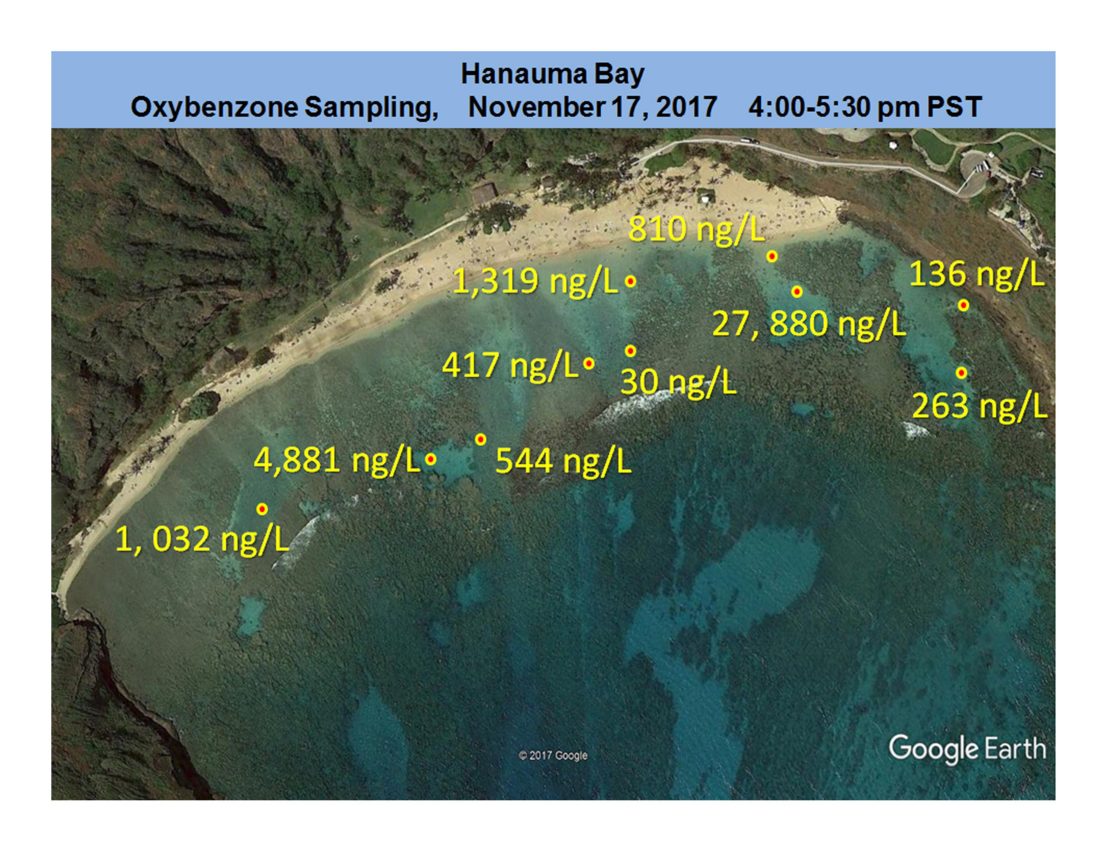Haereticus Lab Study Finds Sunscreen Pollution Threatens Hanauma Bay in Hawaii
Industry: Environment
Oxybenzone chemical in Sunscreens from tourists and visitors are at toxic levels in Hanauma Bay, Hawaii. Hanauma Bay is the coral reef "jewel of Oahu"; over 1 million visitors swim in Hanauma's waters. The pollution from sunscreen is killing these coral reefs, threatening both the ecological integrity and its value as a major tourist attraction. To save Hanauma's coral reefs, oxybenzone in sunscreen needs to be banned.
Hawaii (PRUnderground) April 17th, 2018
A group of non-profit organizations and volunteers sampled the waters of Hanauma Bay on November 17, 2017 to determine the level of a sunscreen chemical, OXYBENZONE, and whether it posed an environmental threat to its coral reefs.
The sampling was conducted in collaboration with non-profits such as Haereticus Environmental Laboratory, Friends of Hanauma Bay, and a number of concerned volunteers, as well as members of several industries, including the sunscreen industry (Raw Elements, All Good) and the Resort & Hospitality Industry (Aqua-Aston Hospitality). Members of the Hawaii State Legislature also participated in the environmental sampling, including Hawaii Senator Will Espero (D), and Hawaii Representative Gene Ward (R).
This sampling event was covered by:
Ten water samples were collected in Hanauma Bay that represented the coral reef closest to the beach. The average concentration of oxybenzone in Hanauma Bay was 4,661 nanograms/liter of seawater. The lowest concentration of Oxybenzone measured in Hanauma Bay was 30 nanograms/liter of seawater. The highest concentration of oxybenzone was 27,880 nanograms/liter of seawater.
Over a dozen scientific papers have demonstrated that OXYBENZONE is highly toxic to marine life, especially coral. Oxybenzone can cause corals to become more susceptible to coral bleaching, it will damage the DNA of coral, and it will deform and kill juvenile coral. Oxybenzone has also been documented to turn adult male fish into female fish, and cause sexually immature, juvenile fish to adopt characteristics common to what is seen in mature, pregnant female fish. Oxybenzone is toxic to shrimp, sea urchins, and bivalves (e.g., scallops, mussels), and is especially toxic to marine algae. A summary of the scientific-environmental literature on oxybenzone can be accessed here: https://www.haereticus-lab.org/oxybenzone-2/
Two separate and independent “Threat Assessments” for the concentrations of Oxybenzone found in Hanauma Bay were conducted for at least a dozen different marine/coral reef organisms. The first threat assessment was conducted by Dr. Silvia Diaz Cruz of the Spanish Council for Scientific Research. She is one of the foremost environmental chemists in the world regarding sunscreen pollution in aquatic and marine environments, as well as human contamination. Dr. Cheryl Woodley of the U.S. National Oceanic & Atmospheric Administration conducted the other independent assessment. Both agencies’ findings indicate that the concentrations of oxybenzone pose an acute risk or threat to marine life. Concentrations of oxybenzone that are above 10 nanograms/liter in seawater pose a threat to coral and other marine life. It can also be argued that oxybenzone is a significant contributor to the degradation of Hanauma Bay’s coral reefs of the past 30 years.
The “Take Home Message” of this study is that Hanauma Bay is experiencing intolerable levels of Oxybenzone Sunscreen Pollution. Under the U.S. Clean Water Act, and being managed by the City of Honolulu, Hawaii’s Department of Land & Natural Resources, and the U.S. National Marine Sanctuary agency, this pollution needs to be recognized and mitigated by these government entities. If nothing is done, then it is easy to predict the Hanauma Bay will further degrade to the point of where it will not be a valued and sought-after resource by locals or the tourism.
One management option, which is being employed by natural resource agencies in Thailand, Indonesia, and the Philippines, is to “shutdown” all tourist access and use to Hanauma Bay. This would allow time for the “coral reef” to recover because the principle stressor – people and their sunscreens – will be alleviated. This ban on tourist access is also used in the Florida Keys National Marine Sanctuary – Special Use Areas.
A second option, which is used by some UNESCO World Heritage sites, is to ban the use and application of all sunscreen products of visitors into Hanauma Bay.
A third option, which is used by Mexico’s marine and terrestrial Eco-parks, is to prohibit the use of sunscreen products that contain oxybenzone.
Industries that rely on ecological sustainability and responsibility are already acting. The resort industry has enacted programs that educate their guests about the dangers of sunscreen pollution. Since April 2017, Aqua Aston Hospitality have taken the extraordinary effort of not just educating their guests, but providing free oxybenzone-free sunscreen throughout the state of Hawaii. Last week, Hawaiian Airlines announced a Safe-Sunscreen program, that includes free oxybenzone-free sunscreen samples, inflight education and films regarding coral reef conservation, and suggested actions that their guests can do to reduce their “sunscreen footprint.” Consumers and tourists can be the decisive factor for successful coral reef conservation and restoration.



